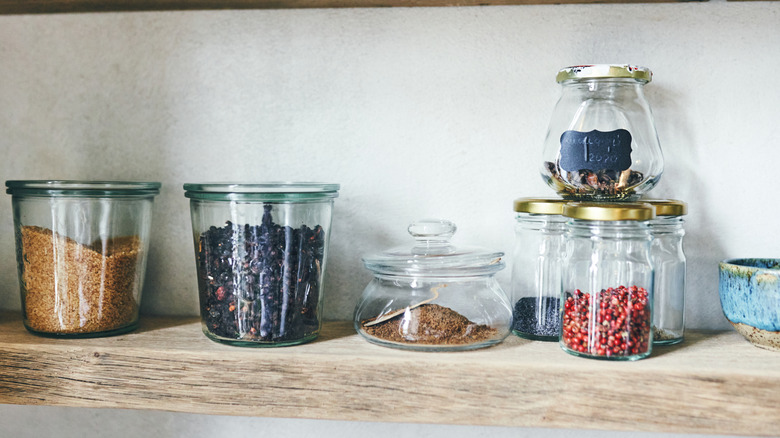This Vintage Kitchen Decor Tip Makes Even The Messiest Spaces Look Tidy
You may have heard the word "larder" mentioned in a movie or a historically accurate book. Nowadays, most of us store our food in pantries and refrigerators, but in the past, a larder was traditionally used as a cool, dry storage space to keep perishable food before refrigeration existed. It was where meat, butter, cheese, jams, baked goods, and other essentials were stored to stay fresh longer. Although this storage space is no longer technically a necessity, the vintage design can be helpful for organization.
Why such a strange name? Yes, it actually is related to lard – meat would be covered in lard to better preserve it, and then stored in this space. While most of us are going to stick to keeping meat in the fridge, a larder is still ideal for storing root vegetables, canned goods, bread, spices, dry grains, and even wine. Having a dedicated larder can help you optimize your fridge space and allow you to remove items that don't need to be refrigerated but do better stored at a cooler temperature. It also offers better visibility of what you have, ideally reducing food waste in the process.
Larders were designed very intentionally, built into the shaded side of a home, outdoors, and sometimes partially underground. This ensured a lower temperature; natural ventilation with small windows and stone shelves helped to maintain a cool temperature. Even if you already have both a pantry and fridge, a larder can help declutter the kitchen strategically.
How to build larder storage into your kitchen
Unless you have purchased a very old home that has come equipped with a larder, you're going to want to choose the right location for one. Keep in mind that larders are not as deep as pantries are, and don't need to be an entire room like sculleries, but are rather a recessed space with shelving. A few ideal options are a corner cabinet or an under-stair closet. A stand-alone cabinet or storage shelf can be added if you have the space for it. If you have free counter space tucked into a corner, shelving can be added above to create a dedicated larder area. Remember to locate it away from direct sunlight, ovens, or heating vents.
You're probably not trying to keep meat and dairy cold, so the materials you choose to use in a larder aren't as important as they were in the past. However, ventilation is still nice to have to keep the items cool, so slatted shelves, baskets, doors with lattice, or a small air vent are a few ideas. A door or curtain can be added to minimize the food's exposure to heat and light.
A mix of shelving will help minimize clutter and help you see where everything is stored more easily. Deep shelves can support baskets of potatoes and onions, while shallow, higher ones can be used for jars and tins. Peg rails can be installed along the larder wall, or the backs and sides of the cabinet to hang herbs or garlic. Heavier items, like jam jars, preserved food, and wine bottles that may not be needed often, can be stored lower in the larder.

